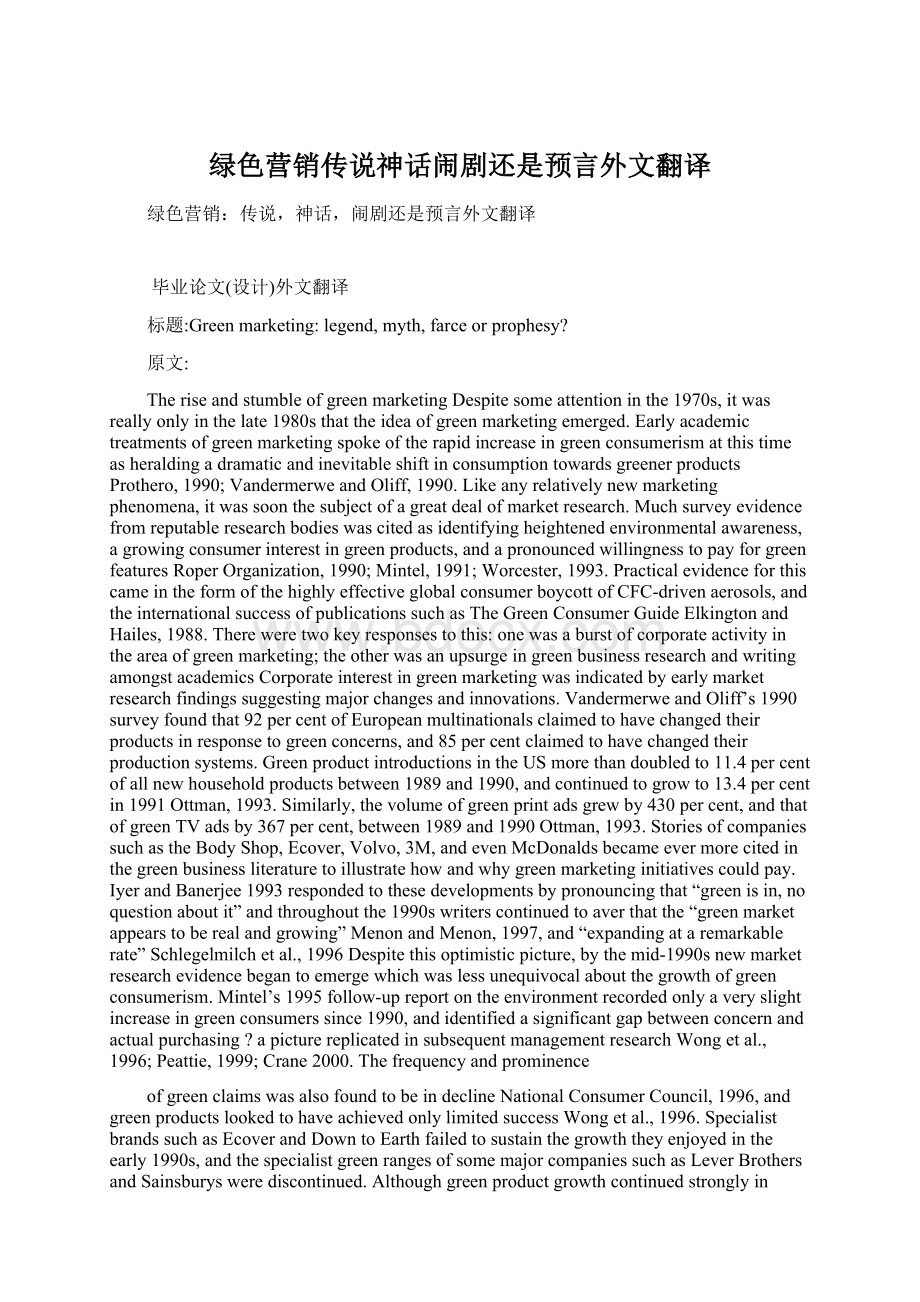绿色营销传说神话闹剧还是预言外文翻译Word文档格式.docx
《绿色营销传说神话闹剧还是预言外文翻译Word文档格式.docx》由会员分享,可在线阅读,更多相关《绿色营销传说神话闹剧还是预言外文翻译Word文档格式.docx(6页珍藏版)》请在冰豆网上搜索。

传说,神话,闹剧还是预言外文翻译
毕业论文(设计)外文翻译
标题:
Greenmarketing:
legend,myth,farceorprophesy?
原文:
TheriseandstumbleofgreenmarketingDespitesomeattentioninthe1970s,itwasreallyonlyinthelate1980sthattheideaofgreenmarketingemerged.EarlyacademictreatmentsofgreenmarketingspokeoftherapidincreaseingreenconsumerismatthistimeasheraldingadramaticandinevitableshiftinconsumptiontowardsgreenerproductsProthero,1990;
VandermerweandOliff,1990.Likeanyrelativelynewmarketingphenomena,itwassoonthesubjectofagreatdealofmarketresearch.Muchsurveyevidencefromreputableresearchbodieswascitedasidentifyingheightenedenvironmentalawareness,agrowingconsumerinterestingreenproducts,andapronouncedwillingnesstopayforgreenfeaturesRoperOrganization,1990;
Mintel,1991;
Worcester,1993.PracticalevidenceforthiscameintheformofthehighlyeffectiveglobalconsumerboycottofCFC-drivenaerosols,andtheinternationalsuccessofpublicationssuchasTheGreenConsumerGuideElkingtonandHailes,1988.Thereweretwokeyresponsestothis:
onewasaburstofcorporateactivityintheareaofgreenmarketing;
theotherwasanupsurgeingreenbusinessresearchandwritingamongstacademicsCorporateinterestingreenmarketingwasindicatedbyearlymarketresearchfindingssuggestingmajorchangesandinnovations.VandermerweandOliff’s1990surveyfoundthat92percentofEuropeanmultinationalsclaimedtohavechangedtheirproductsinresponsetogreenconcerns,and85percentclaimedtohavechangedtheirproductionsystems.GreenproductintroductionsintheUSmorethandoubledto11.4percentofallnewhouseholdproductsbetween1989and1990,andcontinuedtogrowto13.4percentin1991Ottman,1993.Similarly,thevolumeofgreenprintadsgrewby430percent,andthatofgreenTVadsby367percent,between1989and1990Ottman,1993.StoriesofcompaniessuchastheBodyShop,Ecover,Volvo,3M,andevenMcDonaldsbecameevermorecitedinthegreenbusinessliteraturetoillustratehowandwhygreenmarketinginitiativescouldpay.IyerandBanerjee1993respondedtothesedevelopmentsbypronouncingthat“greenisin,noquestionaboutit”andthroughoutthe1990swriterscontinuedtoaverthatthe“greenmarketappearstoberealandgrowing”MenonandMenon,1997,and“expandingataremarkablerate”Schlegelmilchetal.,1996Despitethisoptimisticpicture,bythemid-1990snewmarketresearchevidencebegantoemergewhichwaslessunequivocalaboutthegrowthofgreenconsumerism.Mintel’s1995follow-upreportontheenvironmentrecordedonlyaveryslightincreaseingreenconsumerssince1990,andidentifiedasignificantgapbetweenconcernandactualpurchasing?
apicturereplicatedinsubsequentmanagementresearchWongetal.,1996;
Peattie,1999;
Crane2000.Thefrequencyandprominence
ofgreenclaimswasalsofoundtobeindeclineNationalConsumerCouncil,1996,andgreenproductslookedtohaveachievedonlylimitedsuccessWongetal.,1996.SpecialistbrandssuchasEcoverandDowntoEarthfailedtosustainthegrowththeyenjoyedintheearly1990s,andthespecialistgreenrangesofsomemajorcompaniessuchasLeverBrothersandSainsburyswerediscontinued.Althoughgreenproductgrowthcontinuedstronglyincertainmarkets,suchasfood,tourism,andfinancialservices,acrossthemajorityofmarketstherewasnolongertalkabouttheimpressivegrowthingreenproductintroductionsSo,hasgreenmarketingfailedtochangehowbusinessesbehaveandtomovetheeconomytowardssustainability?
Someoftheresearchevidencecanbeinterpretedeitherway.Criticscanpointtoareductioninadvertisingclaimsasproofofitsdecline,whileothersmightseethisasanimprovementonthelate1980swhenawaveofoftenill-judgedadvertisingcampaignsweremountedbycompaniesinawaythatdrewwidespreadcriticism.Similarly,areductioninspecialistproductscanbeinterpretedasafailure,oritcanreflectthemainstreammarketimprovingitsenvironmentalperformancetothepointthatreducesthedemandforspecialistgreenproducts.Perhapsthemostdamningmarketresearchevidenceinthecaseforthedeclineofgreenmarketingisthealarmingcynicismbeingdisplayedbyconsumersaboutgreenproducts,greenclaims,andthecompaniesbehindthemKangunetal.,1991;
NationalConsumerCouncil,1996.Themarketingphilosophyandprocessisbuiltaroundthecustomerandtherelationshipbetweenthecompanyandthecustomer.Ifthisischaracterisedbycynicismanddistrust,thencompaniesareunlikelytobeabletobringcustomersalongwiththemthroughthechangesneededtomovetowardssustainability.Greenmarketingwillnotworkinthefaceofconsumerdistrust,butthenthatdistrustmaybepartlyaproductofthetypesof“greenmarketings”thatcompanieshaverelieduponsofarFiveroutestofailureReviewingKing’sanalysis,itseemsclearthatmanyoftheproblemsthathavehamperedthedevelopmentofeffectivemainstreammarketinginthepasthavereturnedtohamperthedevelopmentofgreenmarketingaswell.Theseproblemshavecontributedtotheemergenceoffivefailedmanifestationsofgreenmarketing.Theseare:
greenspinning,greenselling,greenharvesting,enviropreneurmarketing,andcompliancemarketingGreensellingThegrowthinmarketresearchidentifyingconsumerconcernabouttheenvironmentduringthe1990smeantthatitwastakenforgrantedinmanyquartersthat“greenwouldsell”andmanyfirmsrespondedbyrapidlyadjustingtheirpromotionalcampaigns.Thisledtowhatwerefertoasa“greenselling”approach,namelyapost-hocidentificationofenvironmentalfeaturesinexistingproducts,thuspromptingausuallyshort-termhopontothegreenbandwagon.Thisreflectedatypicalsalesorientation,sinceinterestintheenvironmenttendedtobelimitedtopromotionalactivity,withlittleornoinputintoproductdevelopment.Thesameproductscontinuedtobeproduced,butgreenthemeswereaddedtopromotionalcampaignsinordertotakeadvantageofanyenvironmentalconcernsofconsumers.However,therewaslittlemarketresearchbyfirmstotrackcustomers’actualneedsandresponses.Evenwhenthesewereinvestigated,theresponsewasoftenfocusedonidentifyingtheenvironmentalbenefitsofexistingproducts,ratherthanseekingalternativestothoseproductsThiswasobviouslyaveryopportunisticresponsetoenvironmentalconcerns.Marketingmanagerscouldscrutinisetheirproductsandproductionprocessessearchingforanindicationthattheirproductwashighinsomethingenvironmentallygood,andifnot,atleastlowinsomethingenvironmentallybad.Itwasthiskindofmindsetthatledtotheconcernamongstregulatorsandconsumergroupsoverthegreenclaimsthatemergedintheearly1990s.Facile,meaningless,andunprovengreenclaimswereslappedonunchangedproductsinfailedattemptstoboostsales,leadingtomountingconsumercynicismandsuspicion,andconcernsaboutapotentialconsumerbacklash.Itisthereforenotsurprisingthatgreenproductshaveoftenunderperformedsignificantly.Somefirmsidentifyingthesetrendshaverealisedthattheirandtheirsuppliers’claimslackedindependentauthentication,andhavesinceattemptedtodevelopcertificationprogrammesinordertoregaincustomerconfidence.However,problemsremain.Therearenowahostofdifferentlogosallegedlycertifyingvariousenvironmentalbenefits,andconsumersareunderstandablyconfused.EveninDenmark,acountrywithapopulationofhighlyconcernedconsumers,only16percentcouldrecognisetheEU“flower”asaneco-labelDEPA,2001.Mistrustofgreenclaimsalsostillendurestotheextentthatmanyfirmswillnowchoosenottomakeanygreenclaimsatallforriskofalienatingcustomers.Failuretoturnasellingorientationintoamarketingonehasthereforemeantthatgreenisnowoftenseenasafruitlessmarketingstrategyamongstmanymajorbusinesses,regardlessoftheenvironmentalqualitiesoftheirproductsGreenharvestingNotallfirmshavetriedtouseenvironmentalclaimstoboostsales,andinfact,manynowareconsciouslychoosingnottoo.However,short-termprofithasremainedthekeyobjectiveofmanyfirmsandmarketingmanagers.Notsurprisinglythen,whenitstartedtobecomeapparentthatgreeningcouldcreatecostsavings,manymarketersbecameenthusiasticabouttheenvironment.Economiesintermsofenergyandmaterialinputefficiencies,packagingreductions,andlogisticsrationalisationprovidedstrongincentivesforfirmstodeveloptheirenvironmentalprogrammes.However,althoughthismayhavemeantthatproductswerenowcostinglesstoproduce,thesesavingsdidnottendtofilterthroughtocustomersintermsofcheaper,greenerproducts.Indeed,onthecontrary,greenproductshavealmostalwaysbeenpricedatapremiumoverconventionalofferings.Sometimesthisreflectstherealitiesoftheproductioncostsinvolved,becauseoftheinternalisingoftraditionallyexternalsocio-environmentalcostsassociatedwithaproduct.Inothercases,itrelateslesstothecostsinvolved,andmoretopricingstrategiesthatseektoestablishgreenproductsaspremiumproductsservingnichemarkets.Overall,thetendencyofgreenproductstobeperceivedasexpensivehasseverelyhamperedtheirmarketpenetrationHavingpluckedthe“lowhangingfruits”ofgreening,manyfirmsfoundthemselvesinapositionwhere,iftheyweretomoveanyfurthertowardssustainability,theyhadtoembracemoreradicalchangeandinvestmoremanagementtimeandmoneytoachieveitShelton,1994.However,ingreenharvestingfirms,wecanusuallyrecognisedeepculturalfixationsoncostreduction,short-termprofitability,